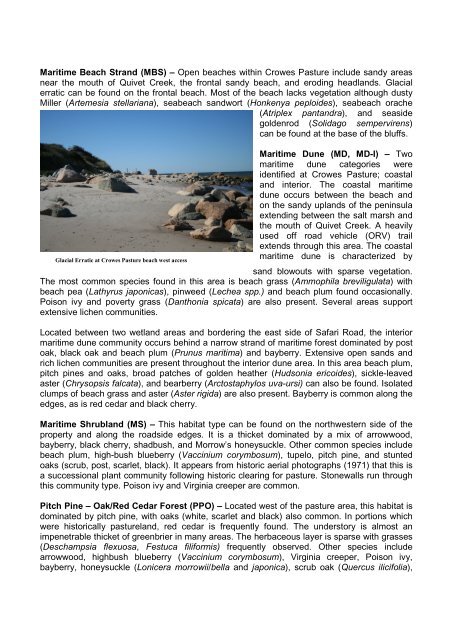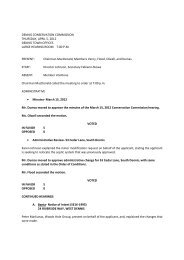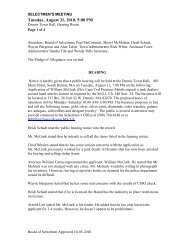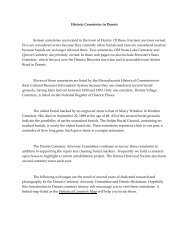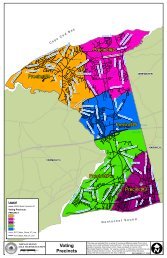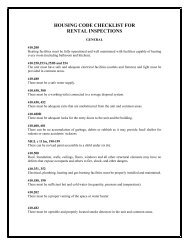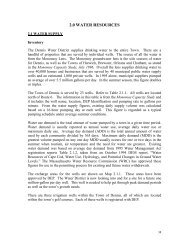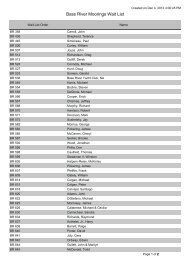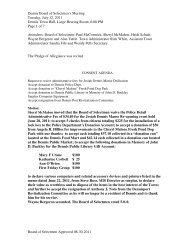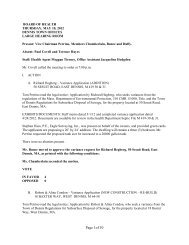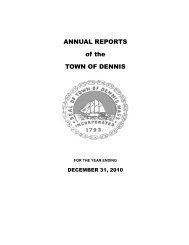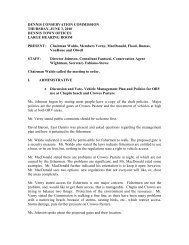Stewardship Plan - the Town of Dennis
Stewardship Plan - the Town of Dennis
Stewardship Plan - the Town of Dennis
Create successful ePaper yourself
Turn your PDF publications into a flip-book with our unique Google optimized e-Paper software.
Maritime Beach Strand (MBS) – Open beaches within Crowes Pasture include sandy areas<br />
near <strong>the</strong> mouth <strong>of</strong> Quivet Creek, <strong>the</strong> frontal sandy beach, and eroding headlands. Glacial<br />
erratic can be found on <strong>the</strong> frontal beach. Most <strong>of</strong> <strong>the</strong> beach lacks vegetation although dusty<br />
Miller (Artemesia stellariana), seabeach sandwort (Honkenya peploides), seabeach orache<br />
(Atriplex pantandra), and seaside<br />
goldenrod (Solidago sempervirens)<br />
can be found at <strong>the</strong> base <strong>of</strong> <strong>the</strong> bluffs.<br />
Glacial Erratic at Crowes Pasture beach west access<br />
Maritime Dune (MD, MD-I) – Two<br />
maritime dune categories were<br />
identified at Crowes Pasture; coastal<br />
and interior. The coastal maritime<br />
dune occurs between <strong>the</strong> beach and<br />
on <strong>the</strong> sandy uplands <strong>of</strong> <strong>the</strong> peninsula<br />
extending between <strong>the</strong> salt marsh and<br />
<strong>the</strong> mouth <strong>of</strong> Quivet Creek. A heavily<br />
used <strong>of</strong>f road vehicle (ORV) trail<br />
extends through this area. The coastal<br />
maritime dune is characterized by<br />
sand blowouts with sparse vegetation.<br />
The most common species found in this area is beach grass (Ammophila breviligulata) with<br />
beach pea (Lathyrus japonicas), pinweed (Lechea spp.) and beach plum found occasionally.<br />
Poison ivy and poverty grass (Danthonia spicata) are also present. Several areas support<br />
extensive lichen communities.<br />
Located between two wetland areas and bordering <strong>the</strong> east side <strong>of</strong> Safari Road, <strong>the</strong> interior<br />
maritime dune community occurs behind a narrow strand <strong>of</strong> maritime forest dominated by post<br />
oak, black oak and beach plum (Prunus maritima) and bayberry. Extensive open sands and<br />
rich lichen communities are present throughout <strong>the</strong> interior dune area. In this area beach plum,<br />
pitch pines and oaks, broad patches <strong>of</strong> golden hea<strong>the</strong>r (Hudsonia ericoides), sickle-leaved<br />
aster (Chrysopsis falcata), and bearberry (Arctostaphylos uva-ursi) can also be found. Isolated<br />
clumps <strong>of</strong> beach grass and aster (Aster rigida) are also present. Bayberry is common along <strong>the</strong><br />
edges, as is red cedar and black cherry.<br />
Maritime Shrubland (MS) – This habitat type can be found on <strong>the</strong> northwestern side <strong>of</strong> <strong>the</strong><br />
property and along <strong>the</strong> roadside edges. It is a thicket dominated by a mix <strong>of</strong> arrowwood,<br />
bayberry, black cherry, shadbush, and Morrow’s honeysuckle. O<strong>the</strong>r common species include<br />
beach plum, high-bush blueberry (Vaccinium corymbosum), tupelo, pitch pine, and stunted<br />
oaks (scrub, post, scarlet, black). It appears from historic aerial photographs (1971) that this is<br />
a successional plant community following historic clearing for pasture. Stonewalls run through<br />
this community type. Poison ivy and Virginia creeper are common.<br />
Pitch Pine – Oak/Red Cedar Forest (PPO) – Located west <strong>of</strong> <strong>the</strong> pasture area, this habitat is<br />
dominated by pitch pine, with oaks (white, scarlet and black) also common. In portions which<br />
were historically pastureland, red cedar is frequently found. The understory is almost an<br />
impenetrable thicket <strong>of</strong> greenbrier in many areas. The herbaceous layer is sparse with grasses<br />
(Deschampsia flexuosa, Festuca filiformis) frequently observed. O<strong>the</strong>r species include<br />
arrowwood, highbush blueberry (Vaccinium corymbosum), Virginia creeper, Poison ivy,<br />
bayberry, honeysuckle (Lonicera morrowii/bella and japonica), scrub oak (Quercus ilicifolia),


